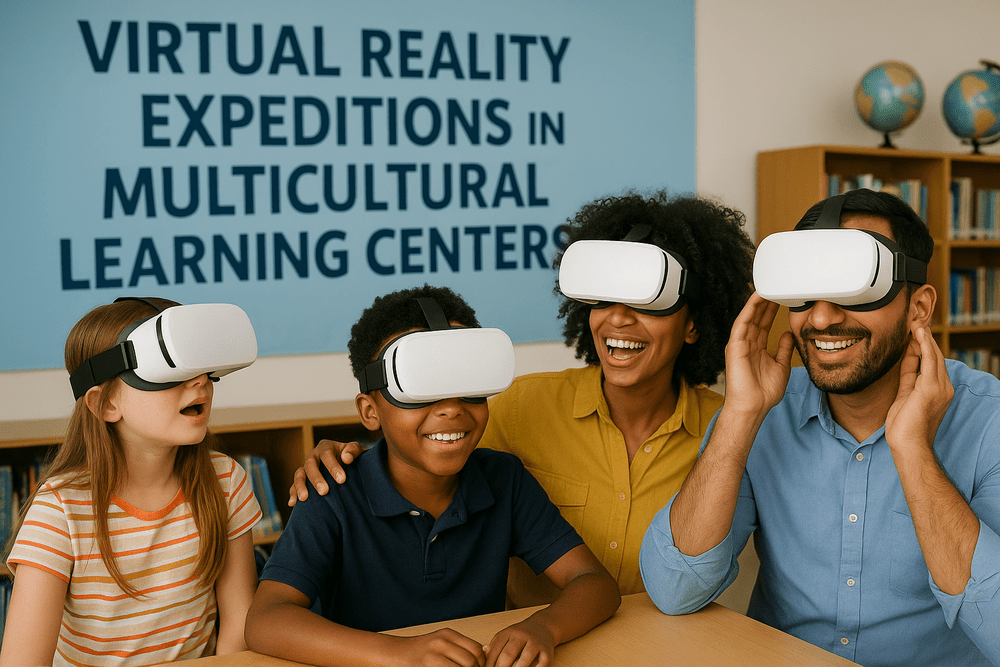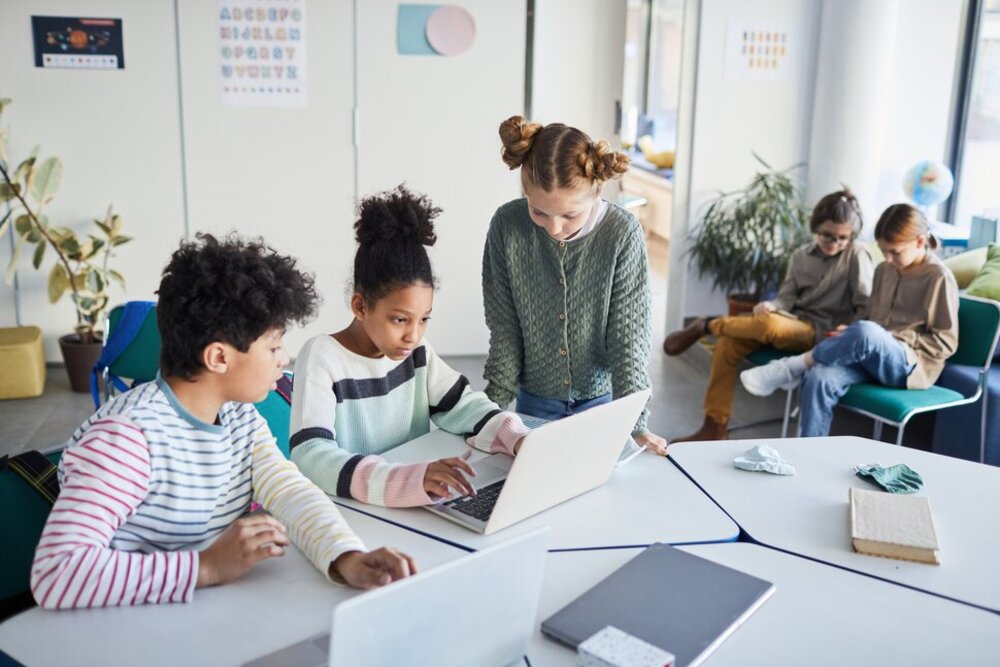Cultural immersion is essential for kids in our globalizing world. Multicultural learning facilities are at the forefront of providing this experience, most notably in states like Los Angeles and California. From charter schools in Canoga Park to integrated schooling in various districts, these centers utilize innovative approaches, including employee dedication and blended curricula, to develop global citizens without crossing a classroom threshold.
All elementary or middle school students gain invaluable lessons from a global world. How do these centers accomplish that? Read on to learn their unique ways of taking students on an international adventure.
1. Virtual Reality Expeditions In Multicultural Learning Centers

At the very hub of California’s education revolution, multicultural learning centers embrace Virtual Reality (VR) technology to transform classrooms into global fields of discovery. This cutting-edge approach allows elementary to middle school students in Canoga Park or across the Los Angeles district to experience many cultures and locations worldwide without stepping outside their school. The committed educators at these charter and MLC schools are creating experiences beyond the traditional models, celebrating the diversity and interdependence of our world.
- Exploratory Learning: VR in schools is not technology, it’s a leap into experiential learning. Kids can stand at the remnants of the ancient Romans, swim at the Great Barrier Reef, or walk through the Sahara, all from the safety and convenience of their California classroom.
- Cultural Immersion: Besides geography, these virtual trips foster a deep appreciation for world cultures. Students get to ‘travel’ to foreign festivals, museums, and landmarks, which leads to appreciation for diversity.
The multicultural learning center staff’s application of VR technology offers an innovative boost to the school curriculum, depicting that learning about the world does not require a plane ticket but merely curiosity and willingness to learn.
2. Language Immersion Programs

Pioneering public charter school innovation, MLCs develop language immersion programs essential to creating global citizens. In California’s culturally diverse learner population, bilingualism is an imperative, not an extravagance, of educational greatness.
Through immersive instruction practices, students from K-8 become bilingual and adept at expressing ideas in two languages. While the California Charter Schools Association welcomes such initiatives, these institutions are setting academic goals for 2024 and the future.
Foreign Language Proficiency
Foreign language proficiency allows students to be reflective citizens of our globalized world.
Dual-Language Classrooms
Teachers utilize dual-language teaching in classrooms, producing a context where students can freely toggle between English and Spanish, as intellectuals such as Gayle Nadler and Myrna Castrejón envisioned.
Language is the cornerstone of intrapersonal and academic success in these public schools, reflecting the district’s emphasis on social justice and equity. Through this pedagogy, MLC students are expected to progress as educated graduates who can act against injustice and act as change agents in their school community and beyond.
3. Cultural Festivals And Celebrations

At the heart of Canoga Park, California, multicultural learning centers (MLCs) transform conventional learning into a splash of vibrant cultural festivals that engage and educate. The festivals are highly significant in conditioning students to understand the importance of world traditions and diversity, capturing the spirit of local and international cultures.
Multicultural Traditions
Celebrating Diwali to Cinco de Mayo, students experience a variety of traditions and learn about the depth of international cultures.
Interactive Activities
Parades, dance performances, and cooking classes for traditional cuisine introduce students to the celebration, making learning enjoyable and memorable.
At MLCs, educators and employees of diverse backgrounds collaborate to make such festivities happen, developing an inclusive environment that reflects Los Angeles’s diversity. These festivals are educational to students and foster camaraderie among elementary—to middle school-age students, inculcating the culture of diversity in every learning area.
By these festivals, California charter school MLCs ensure that education is not only outside the classroom but also molds students as they grow into well-rounded individuals ready to enter a multicultural world.
4. International Pen Pals And Video Exchanges
MLCs are pioneering a borderless global classroom where K-8 students from diverse communities are connected through global pen pals and video links. This forward-thinking vision of the public charter school is producing global citizens who possess empathy, bilingual communications, and an appreciation of cultural and individual differences. Here’s why the connections matter:
- Face-to-Face Interactions with International Peers: Students engage with international peers, perceiving the world through the eyes of another and gaining a rich understanding of various perspectives.
- Facilitating International Exchange: Teachers, with cutting-edge technology and MLC’s global network, carefully match the students with their international counterparts, providing a setting in which cultural and individual subtleties are valued.
These interactions, directed by educators committed to equity and inclusion, go beyond conventional academic studies to effectively equip students to address real-world problems. They are the pillars for intrapersonal accomplishment, helping students recognize different viewpoints and acquire the capabilities necessary to voice ideas in two languages.
5. Cooking Classes Featuring Global Cuisines
The payoff? MLC graduates are fluent and educated world citizens, ready to battle for justice and leave a positive footprint on the more globalized world. Cooking Classes with International Cuisine
Food is at the heart of every culture. Multicultural Learning Centers (MLCs) serve a delicious learning experience with cooking classes, transporting taste buds globally. Here’s how the MLC recipe serves up food, culture, and education:
Uncovering Cultural Roots Through Food
Children experience other cultures by cooking up artworks from across the globe, understanding that every ingredient has a story.
Food And Learning
From rolling sushi California-style to preparing authentic Canoga Park tamales, kids are learning not only about cooking but also about geography, history, and the taste of diversity.
Each meal made is a learning experience of world cultures. They are dipped into the Los Angeles culinary melting pot as staff incorporate the taste of heritage in each lesson, representing the school system’s diversity.
These MLCs, amidst California’s dynamic communities, illustrate that learning in a charter school can be beyond textbooks. They pay homage to Los Angeles’s cultural mosaic, bite by bite. It’s not cooking—it’s a pilgrimage.
6. Cross-cultural Art Projects
In MLCs, art does not mean colors and shapes—a vibrant tribute to our world’s multicultural tapestry. Students are masters of the art of diversity through working on art pieces with profound cultural significance. This is the way MLCs internationalize art in meaning:
- Reflecting Societies Through Art: Each paint stroke and hand-formed clay piece of MLC’s cross-cultural art is not random—it’s a dialogue with history and identity.
- Global Gallery: Students design genuine tribal masks, paint U.S.-themed murals, and replicate ancient pottery, each an introduction to learning about other cultures and periods.
A K-8 public charter school, MLC is dedicated to building a diverse learning community that supports academic excellence and equity. Through art, teachers inspire students to view things from other perspectives, not just for the next school year, but as responsible global citizens.
Through the combination of artistic exploration with social justice, MLC’s inclusive community ensures that diversity is not only identified and celebrated as the basis of a healthy, compassionate school community.
7. Ethnic Music And Dance Workshops
Lying at the core of MLC’s educational strategy is the beat of ethnic music and the rhythm of dance, above language, and bringing students in Canoga Park together through the lively celebration of diversity. This is a snapshot of the life-changing experiences:
Each strum, beat, and twirl in the workshops is a rhythm of togetherness, showing students the rich rhythms of global traditions. Music and dance are woven into the curriculum so meticulously that students can study and direct—one minute Afro-Cuban rhythms; the next, Bollywood-inspired dance performances.
MLC is not a school; it’s a cultural crossroads where children from elementary through middle school in the Los Angeles school district learn the world’s rhythms and strides. This multicultural learning center—the nexus located within the diversity-rich community of Canoga Park, California—makes every child an ambassador of cultural unity.
By attending MLC’s workshops, students don’t just reboot their creative skills—they become clear communicators of their heritage stories and forge bonds that reverberate far beyond the charter school grounds.
8. Global Issues Discussions And Model UN
Sit in on the world forum without leaving school—MLC’s new Model UN and international discussions bring our multicultural family of students to the forefront of global issues. Learnings here are gigantic:
Young Diplomats
MLC’s model empowers K-8 students to study the subtleties of global issues, creating mini-ambassadors who will make decisions with their heads and hearts.
Model UN Impact On Real Life
Students learn through role-playing as delegates, sharpening their diplomacy, conflict resolution, and public speaking skills. This mini United Nations prepares a generation of well-educated global citizens.
This public charter school is more than a hub; it is a crucible where cultural and individual disparities forge academic excellence and equity-minded leaders. With the school year ending, MLC fosters an environment where test scores and social justice cross with environmental stewardship.
The combined effect runs deep—graduates are not merely knowledgeable and socially and intrapersonally competent, but can also express ideas in two languages and act for justice. This bilingual public charter school is not just teaching—it is lifting the world’s international community of architects of the future.
